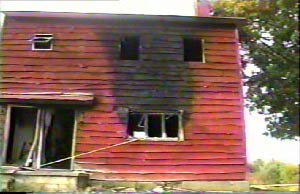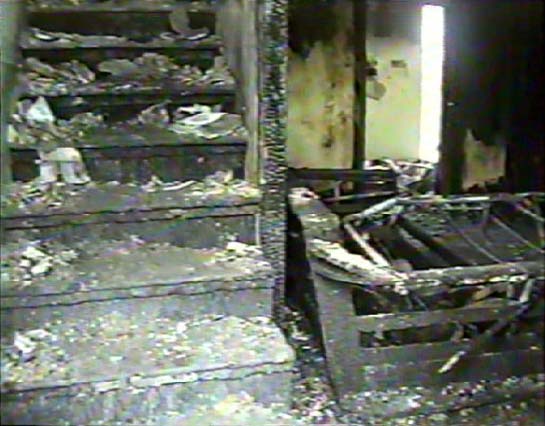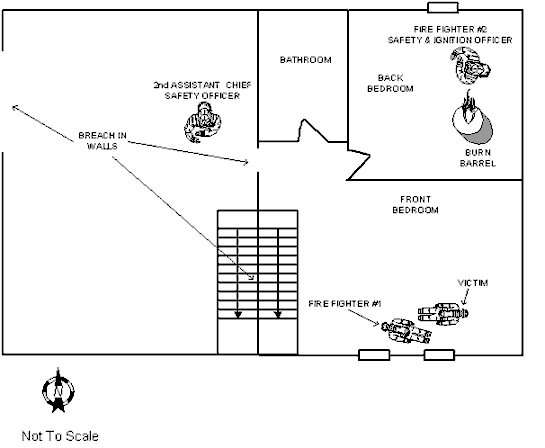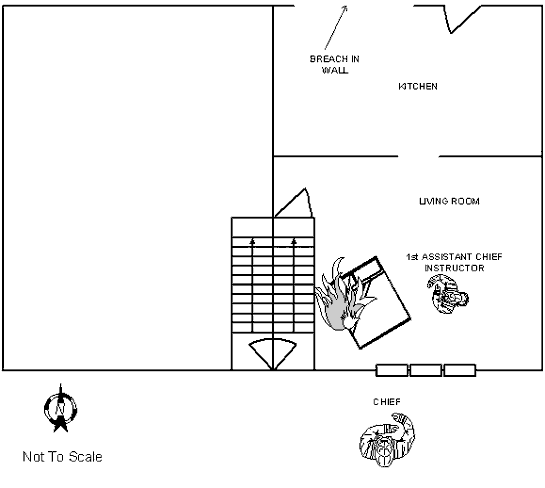

Volunteer Fire Fighter Dies and Two Others Are Injured During Live-Burn Training - New York
SUMMARY
On September 25, 2001, a 19-year-old male volunteer fire fighter (the victim) died and two male volunteer fire fighters (Fire Fighter #1 and Fire Fighter #2) were injured during a multi-agency, live-burn training session. The victim and Fire Fighter #1 were playing the role of fire fighters who had become trapped on the second-level of the structure. The training became reality when the fire was started and progressed up the stairwell, accelerated by a foam mattress that was ignited on the first floor. Fire Fighter #1 and the victim were recovered from the second-level front bedroom where they had been placed for the training. Fire Fighter #2 jumped from a second-level window in the rear bedroom. The victim was unresponsive when removed from the structure. Advanced life saving procedures were initiated on the victim en route to the local hospital where he was pronounced dead. Fire Fighter #1 and Fire Fighter #2 suffered severe burns and were airlifted to an area burn unit.
NIOSH investigators concluded that to minimize the risk of similar occurrences, fire departments should
Additionally,

Site of the Incident
INTRODUCTION
On September 25, 2001, a fire fighter (the victim) died and two fire fighters (Fire Fighter #1 and Fire Fighter #2) were injured while participating in a multi-agency, live-burn training session. The victim and Fire Fighter #1 were playing the role of fire fighters who had become trapped in a structure on the second level.
On September 27, 2001, the United States Fire Administration notified the National Institute for Occupational Safety and Health (NIOSH) of this incident. On December 4-5, 2001, two safety and occupational health specialists and the section chief from the NIOSH Fire Fighter Fatality Investigation and Prevention Program investigated this incident. Interviews were conducted with the Chief, the Assistant Chiefs, and fire fighters of the departments from the district involved in the training session. The department that was operating the training was disbanded. Copies of their standard operating procedures were not available for review. The training records of the victim and injured fire fighters were reviewed.
The fire district involved in this multi-agency training session operated from four volunteer stations and was comprised of 102 active members. The district serves a population of approximately 25, 000 in a geographic area of about 25 square miles. The victim had been a volunteer fire fighter for just a few weeks and had not received any formalized training before the incident. Fire Fighter #1 was reported to have received Basic Fire Fighting Essentials, Maze Training, and Live Tower Training, but no documentation was provided during the investigation. Fire Fighter #2 was documented to have completed Fire Fighting Essentials, Pump Operator, Commanding the Initial Response, Apparatus Operator, and Hazardous Materials First Responder Operations. The site was a two-story, side-by-side duplex. Vacant and in disrepair, the duplex was scheduled for demolition in the near future by the owner.
INVESTIGATION
At approximately 1845 hours, Fire Fighter #1, Fire Fighter #2, the victim, the 1st Assistant Chief, and the 2nd Assistant Chief were on the scene discussing the plan for a rescue drill during live-burn training. The 1st Assistant Chief was the instructor. The 2nd Assistant Chief was a Safety Officer for the west unit of the duplex. Fire Fighter #2 was a Safety Officer for the east unit and the Ignition Officer. The following apparatus were on the scene before the start of the training:
Engine #451 equipped with a 1,000-gallon water tank
Engine #3 equipped with a 1,000-gallon water tank
Heavy Rescue #449
Rescue #1
Truck #459
10,000-gallon water tanker (building owner’s)
The training scenario was designed to include two fire fighters who had become trapped while conducting a search for an infant in a bedroom located on the second floor of a duplex apartment. Note: The fire fighters that were used to simulate victims during this training session will be referred to as the "trapped fire fighters" throughout this report. Engine #451 was to hook up to the owner’s water tanker on site and have two 1¾" handlines stretched to the structure, one handline to the rear entrance and one handline to the front entrance of the east unit. Engine #3 and Heavy Rescue #449 were then dispatched to stage approximately ¾ of a mile away to practice their response to the scene. The scenario included blocking the door to the stairs of the unit (east unit) leading to the "trapped fire fighters" to simulate that the stairs had collapsed. The responding units would have to deploy a rapid intervention team (RIT) which would then be forced to access the second floor via the stairs on the other side of the duplex. Once on the second floor, the RIT would breach the wall leading to the other apartment to conduct a search for the "trapped fire fighters"and the infant. Note: The wall on the second floor separating the two units had been breached during earlier training sessions. The "trapped fire fighters" (Fire Fighter #1 and the victim) were placed in the front bedroom with some debris scattered about the floor and a Ping-Pong table placed upon them to simulate a real entrapment. Note: This was reportedly the first time the victim had worn a self-contained breathing apparatus (SCBA) in a fire condition. Fire Fighter #1 had approximately 1 year with the department and minimal experience with an SCBA in fire conditions. A burn barrel was to be used to produce smoke and simulate fire from the back bedroom of the east duplex.
The 2nd Assistant Chief was positioned with a 20-pound fire extinguisher on the second floor of the west unit to guide the RIT up the stairs and through the breach in the wall. He was to ensure the RIT did not go through an opening in the back wall of the west unit. Fire Fighter #2 was on the second floor of the east unit where he was to place the "trapped fire fighters" in the front bedroom, light the burn barrel in the back bedroom, and guide the RIT if necessary (Diagram #1). The Chief arrived on the scene and did a walkthrough of the upstairs to ensure safety and to make sure no accelerants were used in the burn barrel. He then proceeded to the front of the duplex and took over outside command as requested by the 1st Assistant Chief, who had interior command from the first floor of the burn unit (Diagram #2).
Fire Fighter #2 struck a flare and lit the burn barrel on the second floor and radioed to the Chief at approximately 1855 hours that it was lit. He then positioned himself in the hallway to guide the RIT if necessary. The barrel was not producing smoke, so Fire Fighter #2 went to the back bedroom to assist in the process. During this time, the 1st Assistant Chief struck another flare on the first floor and lit the foam mattress of a sleeper sofa that was extended adjacent to the open side of the stairs.
Fire Fighter #2 heard the second flare being struck and went to investigate. In a matter of seconds, the flames began to roll across the ceiling, up the stairs, and out the front windows of the burn unit, producing what was described as a thick, "steamy" smoke. The 2nd Assistant Chief was cut off from the east unit by the fire extending up the stairwell. He exited via a ladder through an opening in the back wall of the west unit. The 1st Assistant Chief went out the back of the structure to locate a handline. Unable to locate a handline in the back of the structure, he searched for a handline at the front of the structure. Note: No handlines had been stretched from Engine #451 before the start of the training evolution. Flames were now extending out of the first-floor bay window into the front bedroom. He then pulled 200 feet of 1¾ inch preconnect off Engine #451 and advanced the line to the rear of the structure.
Fire Fighter #2 went to retrieve the "trapped fire fighters" from the front bedroom where flames were already coming through the windows from downstairs. Fire Fighter #2 grabbed the two "trapped fire fighters" and led them to the stairwell, which was fully engulfed. Fire Fighter #2 lost his fire gloves in the process, exposing the leather gloves he had worn underneath. The leather gloves immediately burned and adhered to his skin. He and the "trapped fire fighters" became separated. Fire Fighter #2 made it to the back bedroom where the burn barrel was located. Conditions in the back bedroom were extremely smoky with little heat. Fire Fighter #2 frantically searched for the window that had been boarded shut to aid in the smoke conditions. He was able to pry the window open with his hands, and he jumped from the second floor just as the 1st Assistant Chief arrived with the handline.
The two staged engines proceeded to the scene under normal driving conditions as planned for the training operations. Once on the scene, they were immediately informed that this was no longer a drill, that two fire fighters were down on the second floor, and that one fire fighter had jumped from the second-story window. Due to the circumstances, both engines deployed a RIT team. The first RIT made forcible entry through the front door of the east unit and proceeded up the stairs to the front bedroom. They immediately found Fire Fighter #1 and dragged him down the stairs by his turnout gear to the lawn in front of the duplex. The second RIT proceeded to the front bedroom and found the victim. They dragged the victim to the front of the duplex for immediate assistance. Note: Both the victim and Fire Fighter #1 were found wearing their facepieces. Burn injuries to the faces of both fire fighters indicated that their masks had been removed during the fire’s progression. The victim was unresponsive when removed from the structure. Advanced life saving procedures were initiated on the victim en route to the local hospital where he was pronounced dead. Fire Fighter #1 and Fire Fighter #2 suffered severe burns and were airlifted to an area burn unit.
CAUSE OF DEATH
The cause of death was listed as asphyxia due to smoke inhalation.
RECOMMENDATIONS AND DISCUSSION
Recommendation #1: Fire departments should ensure that no one plays the role of victim inside the structure during live-burn training. 1
The National Fire Protection Association Standard 1403, 2-4.13, notes that individuals shall not play the role of a victim inside the building. Rescue operations should be conducted by using mannequins instead of fire fighters, just as the mock baby was used to simulate the infant.
Recommendation #2: Fire departments should ensure that a certified instructor is in charge of the live-burn training and that a separate safety officer is appointed and has the authority to intervene and control any aspect of the operation. 1
Fire departments should comply with the National Fire Protection Association Standard 1403, which notes that all instructors shall be deemed qualified to deliver fire-fighter training by the authority having jurisdiction. The instructor-in-charge should be a certified instructor who oversees all aspects of the training session. Their responsibilities include planning and coordinating all training activities, monitoring activities, structure inspections, briefing and assigning instructors and support personnel, and ensuring adherence to the directives. The authority having jurisdiction in this area does not have any requirements or procedures in place for determining if an instructor is qualified to provide fire-fighter training as outlined in NFPA 1041, Standard for Fire Service Instructor Professional Qualifications.
NFPA Standard 1403 further states that safety officers shall be appointed for all training sessions and have no other duties to interfere with their safety responsibilities for all persons on the scene. The safety officer should eliminate unsafe conditions, prevent unsafe acts, coordinate lighting of fires with instructor-in-charge, ensure personal protective equipment compliance, ensure all participants are accounted for before and after each evolution. The safety officer must have the authority to intervene and control all aspects of the operation. One of the safety officers during this incident also had the responsibility of the ignition officer to light the burn barrel on the second floor.
A person who is not a student should be designated as the ignition officer to control the material being burned. The fire should be ignited by the ignition officer in the presence of and under the direct supervision of the safety officer.
Recommendation #3: Fire departments should ensure that only one training fire is ignited at a time by a designated ignition officer and that a charged hoseline is present while igniting the fire. 1
One person, who is not participating in the training, should be assigned the duty of ignition officer and light the fire as instructed by the instructor-in-charge. The safety officer should be in the presence of, and have direct supervision over, the ignition officer when the fire is lit. A charged hoseline should be present when igniting the fire.
Recommendation #4: Fire departments should ensure that Standard Operating Procedures (SOPs) are developed and followed. 2
Standard operating procedures (SOPs) should be developed addressing emergency-scene operations such as Training Fires, RIT Operations, SCBA, Water Supply, and Hoseline Operations. These SOPs will then form the foundation as to how the training will be conducted. The SOP should be in written form and included in the overall risk-management plan for the fire department. If these procedures are changed, appropriate training should be provided to all affected members.
Recommendation #5: Fire departments should ensure that all fire fighters participating in live-burn training have achieved a minimum level of basic training. 1
To ensure safety during live-burn training, all fire fighters should have a minimum level of basic training. As stated in NFPA 1403, 2-1.2, the fire fighter student shall have received training to meet the performance objectives for Fire Fighter 1 of the following sections of NFPA 1001, Standard for Fire Fighter Professional Qualifications:
Section 3-3 Safety
Section 3-5 Fire Behavior
Section 3-6 Portable Extinguishers
Section 3-7 Personal Protective Equipment
Section 3-11 Ladders
Section 3-12 Fire Hose, Appliances and Streams
Section 3-16 Overhaul
Section 3-19 Water Supply
Recommendation #6: Fire departments should ensure that before conducting live-burn training, a preburn briefing session is conducted and an evacuation plan and signal are established for all participants. 1, 2
All participants should attend a preburn briefing before conducting the live-burn training session to discuss all facets of the training. The instructor in charge of the training should present the briefing session using the preburn plan to detail all aspects of the operation. The characteristics of the training area and structure should be addressed to include such items as crew assignments and the designation and layout of ingress/egress routes in the event of emergency. An evacuation plan should be established and an audible evacuation signal be demonstrated to all participants in an interior live-burn training evolution. It is imperative that all participants are familiar with the layout of the structure. All participants should conduct a walk-through of the structure before any training evolutions are initiated.
Recommendation #7: Fire departments should ensure that fires used for live-burn training are not located in any designated exit paths. 1
During a training exercise, every effort must be made to ensure the exit paths are free from obstructions. To provide a protected area of travel, fires should not be located in any exit paths. These areas should be closely monitored to ensure that fire does not spread during the training exercise. The sofa bed was located at the bottom of the stairs leading to the front exit. The front exit was blocked to simulate that the stairs had collapsed for the responding RIT. Once the sofa bed was lit, the fire immediately traveled into the exit path using the stairway as a chimney. To enhance the smoke conditions for the evolution, the windows on both floors were boarded over or partially covered to minimize ventilation. When the fire entered the exit path, the training exercise became a working structure fire.
Recommendation #8: Fire departments should ensure that the fuels used in the live-burn training have known burning characteristics and the structure is inspected for possible environmental hazards. 1
Fuels for training fires should have known burning characteristics, and the quantities used should be the minimum necessary that are controllable and able to create the desired fire conditions. The structure should be inspected to identify and remove materials that could contribute to rapidly spreading fires and create an environmental or health hazard. The structure must also be inspected to provide for physical safety of the participants in the training. NFPA 1403, 2-2.10, identifies the following items that should be addressed:
Additionally,
Recommendation #9: States should develop a permitting procedure for live-burn training to be conducted at acquired structures. States should ensure that all the requirements of NFPA 1403 have been met before issuing the permit. 1, 3
Discussion: NFPA 1403, Standard on Live Fire Training Evolutions, is the guideline for conducting live-burn training evolutions at approved training centers, and in this case, acquired structures. Approved training centers have burn buildings that are specifically designed for repeated live-burn training evolutions. The structures that are acquired for live-burn training are usually in disrepair and were never designed for live- burn training. Any building that is acquired for live-burn training must go through an inspection process to identify and eliminate any hazards, or potential hazards, that may be present to the participants, the public, and the environment. An application for permit procedure that is overseen by the state through local officials or a State representative would help ensure safety. If training facilities with approved burn buildings are available, then live-burn training exercises should not be conducted in acquired structures.
REFERENCES
INVESTIGATOR INFORMATION
This incident was investigated by Jay Tarley and Tom Mezzanotte Safety and Occupational Health Specialists, and Robert Koedam, Section Chief, Trauma Investigations Section, Surveillance and Field Investigations Branch, Division of Safety Research, NIOSH.

Photo. Sleeper Sofa Adjacent to Stairwell

Diagram 1: Second Floor Aerial View

Diagram 2: First Floor Aerial View
Return to Fire Fighter Homepage
This page was last updated on 10/30/02